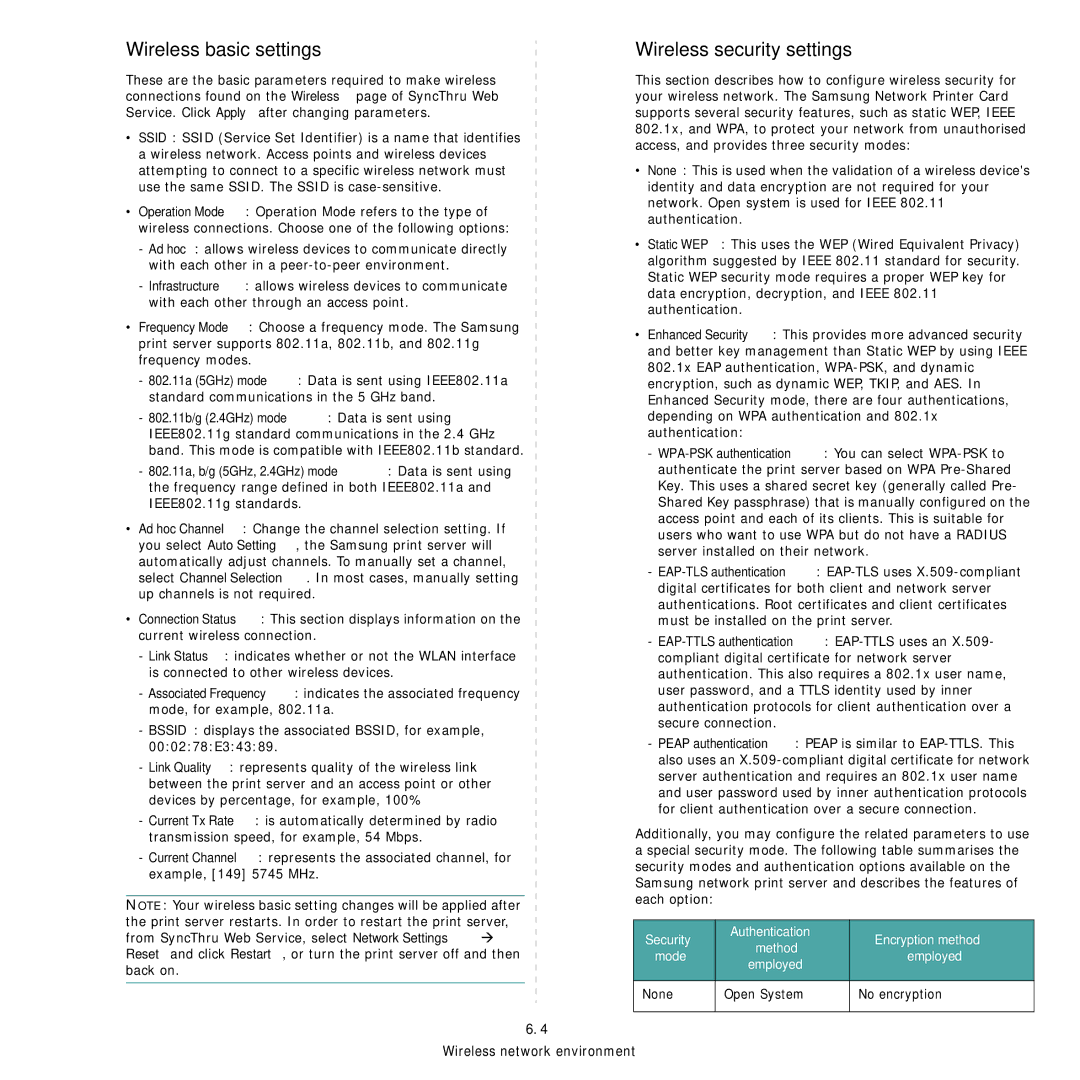
Wireless basic settings
Wireless security settings
These are the basic parameters required to make wireless connections found on the Wireless page of SyncThru Web Service. Click Apply after changing parameters.
•SSID: SSID (Service Set Identifier) is a name that identifies a wireless network. Access points and wireless devices attempting to connect to a specific wireless network must use the same SSID. The SSID is
•Operation Mode: Operation Mode refers to the type of wireless connections. Choose one of the following options:
-Ad hoc: allows wireless devices to communicate directly with each other in a
- Infrastructure: allows wireless devices to communicate with each other through an access point.
•Frequency Mode: Choose a frequency mode. The Samsung print server supports 802.11a, 802.11b, and 802.11g frequency modes.
-802.11a (5GHz) mode: Data is sent using IEEE802.11a standard communications in the 5 GHz band.
- 802.11b/g (2.4GHz) mode: Data is sent using IEEE802.11g standard communications in the 2.4 GHz band. This mode is compatible with IEEE802.11b standard.
-802.11a, b/g (5GHz, 2.4GHz) mode: Data is sent using the frequency range defined in both IEEE802.11a and IEEE802.11g standards.
•Ad hoc Channel: Change the channel selection setting. If you select Auto Setting, the Samsung print server will automatically adjust channels. To manually set a channel, select Channel Selection. In most cases, manually setting up channels is not required.
• Connection Status: This section displays information on the current wireless connection.
-Link Status: indicates whether or not the WLAN interface is connected to other wireless devices.
-Associated Frequency: indicates the associated frequency mode, for example, 802.11a.
-BSSID: displays the associated BSSID, for example, 00:02:78:E3:43:89.
-Link Quality: represents quality of the wireless link between the print server and an access point or other devices by percentage, for example, 100%
- Current Tx Rate: is automatically determined by radio transmission speed, for example, 54 Mbps.
-Current Channel: represents the associated channel, for example, [149] 5745 MHz.
NOTE: Your wireless basic setting changes will be applied after the print server restarts. In order to restart the print server, from SyncThru Web Service, select Network Settings Æ Reset and click Restart, or turn the print server off and then back on.
6.4
This section describes how to configure wireless security for your wireless network. The Samsung Network Printer Card supports several security features, such as static WEP, IEEE 802.1x, and WPA, to protect your network from unauthorised access, and provides three security modes:
•None: This is used when the validation of a wireless device's identity and data encryption are not required for your network. Open system is used for IEEE 802.11 authentication.
•Static WEP: This uses the WEP (Wired Equivalent Privacy) algorithm suggested by IEEE 802.11 standard for security. Static WEP security mode requires a proper WEP key for data encryption, decryption, and IEEE 802.11 authentication.
•Enhanced Security: This provides more advanced security and better key management than Static WEP by using IEEE 802.1x EAP authentication,
-
-
-
-PEAP authentication: PEAP is similar to
Additionally, you may configure the related parameters to use a special security mode. The following table summarises the security modes and authentication options available on the Samsung network print server and describes the features of each option:
Security | Authentication | Encryption method | |
method | |||
mode | employed | ||
employed | |||
|
| ||
|
|
| |
None | Open System | No encryption | |
|
|
|
Wireless network environment
